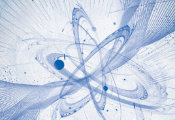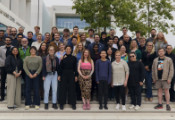Quantum Electrodynamic Theory Reaching Extreme Precision
December 16, 2024 -- New “two-loop” calculations tackled a tricky piece of the quantum electrodynamic (QED) puzzle with unprecedented precision: the electron self-energy. The result updates the Lamb shift, leading to a relevant adjustment in the Rydberg constant – a key number in atomic physics. In addition, two-loop corrections were successfully applied to determine the magnetic properties of hydrogen-like tin ions. These refined calculations pave new ways to study atomic nuclei properties and to improved searches for new physics.
Quantum electrodynamics, or QED, is one of the crown jewels of modern physics. This theory explains how light and matter interact at the quantum level and has been tested to extraordinary precision. One of its most famous breakthroughs dates back to the 1940s when physicists studying atomic hydrogen uncovered a subtle energy shift, now called the Lamb shift. This discovery was a major milestone in physics, one of the first windows into the quantum nature of electromagnetism. Fast forward to today, and QED is sharper than ever. It can predict the Lamb shift with such accuracy that scientists use it to determine the Rydberg constant - a key number in atomic physics. This constant is essential for ensuring that calculations match experimental data when probing atomic systems with light.
Recently, researchers from at the Max Planck Institute for Nuclear Physics (MPIK) in Heidelberg tackled a tricky piece of the QED puzzle. They focused on a phenomenon known as the electron self-energy, which occurs when an electron interacts with the quantum vacuum — the invisible sea of energy that pervades the whole universe. The electron briefly emits and reabsorbs “virtual” photons, particles so fleeting that they can’t be directly detected but still leave a measurable imprint. To predict this effect with high precision, physicists must account for scenarios where the electron interacts with two virtual photons. It’s a daunting challenge, previously approached using approximations based on the assumption that the electron orbits around the nucleus much slower than the light. But Vladimir Yerokhin from the theory division of Christoph H. Keitel at MPIK went a step further, performing the calculations without any such simplifications. The result is a surprising update to the Lamb shift, which led to a small adjustment in the Rydberg constant — shrinking it by just one part in a trillion and refining its uncertainty by the significant factor of 1.4.
The Lamb shift isn’t the only way QED leaves its mark on atomic systems. Another key property of the electron is its spin, a fundamental trait that turns the electron into a tiny magnet. In a magnetic field, this magnetism creates two distinct quantum states for the electron — one corresponding to a “clockwise” rotation and the other to “counterclockwise” rotation. The energy difference between these states defines the g-factor, a value that physicists can measure and calculate with incredible precision.
Here’s where it gets exciting: similar quantum effects that influence the Lamb shift also tweak the g-factor. Until recently, scientists hadn’t fully worked out how these “two-loop” corrections play into the g-factor. But Bastian Sikora and his colleagues after five years of demanding calculations cracked this mystery applying their calculations to a tin ion — a hydrogen-like atom with a powerful nuclear charge. Now, their work shaved down the uncertainty in the g-factor’s theoretical value, making it one digit more precise than before. Even more intriguing, these refined calculations could open up new ways to study atomic nuclei. By using the g-factor as a probe, scientists might soon measure the size of nuclei with unprecedented accuracy, unlocking deeper insights into these building blocks of matter.




































